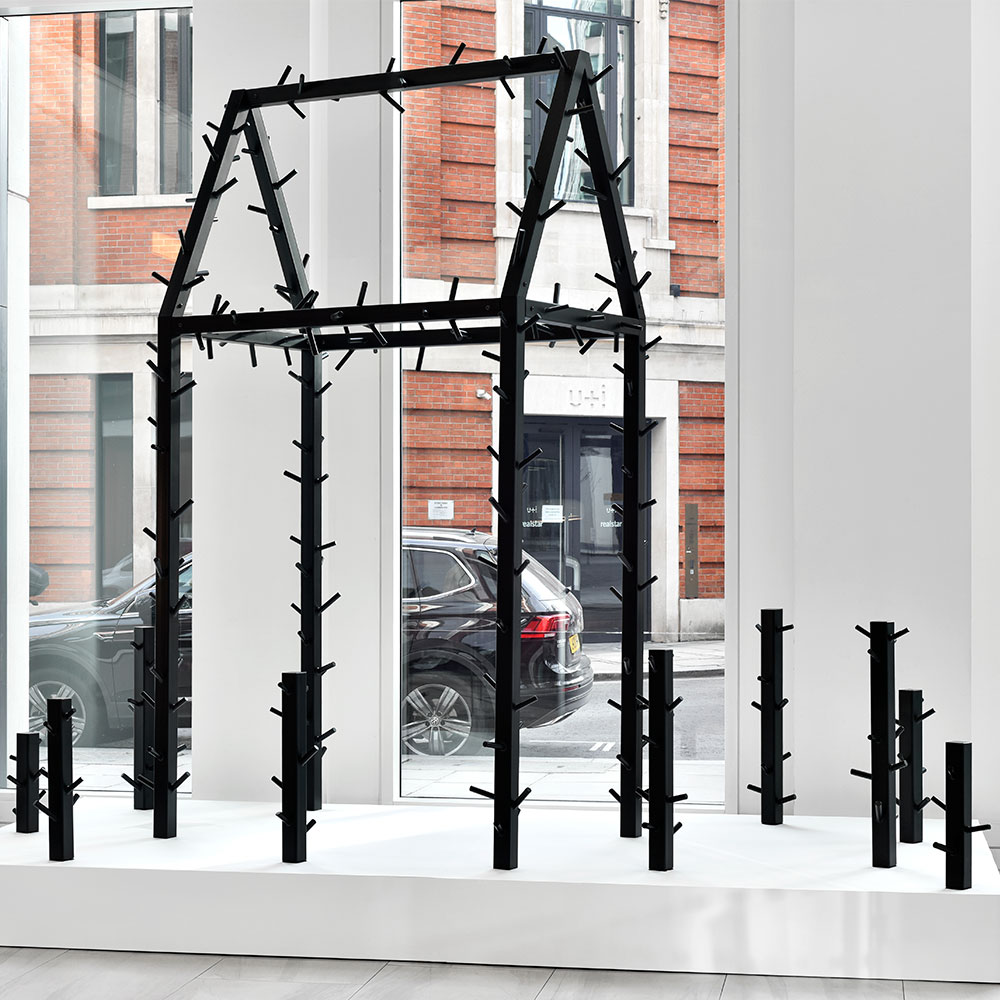Permindar Kaur: Home
Review by Piers Masterson
Permindar Kaur’s exhibitions often create feelings of anxiety. Cuddly toys and nursery room furniture would be given abject twists, kid’s dolls and clothes sporting metal claws or daggers and razor wire cribs would speak to the most Freudian nightmares of threat in the domestic family space. The impact of Kaur’s installations is heightened by having the secluded scenes of English family life played out in an institutional gallery setting, with the subsequent unsettling collision of public and private arenas. The exhibition ‘Home’ takes place in the foyer of the mixed retail, office and residential block of Howick Place. And while the presentation is complicated by restricted access due to the building’s nature, ‘Home’ is consistent with themes of contested boundaries between domestic and communal spaces that have often featured in Kaur’s sculptures over 25 years.
A pair of outsized highchairs, titled ‘Tall Chairs’ (1996), teeter precariously in the corner of the lobby, each supporting a folded up, orange child romper suit that look like the aftermath of some ghastly primary school atrocity. Kaur’s use of orange is significant not just in relation to Sikhism but several religions in which orange is seen as the colour of sainthood and martyrdom. The fetishised onesies echo the mementoes of baby clothes left at religious shrines. Notably, Howick Place is only a short distance from Westminster Cathedral and Westminster Abbey: sites more usually associated with such public anguish.
‘Tall Chairs’ has been placed behind the reception’s security barrier where, despite its minimalist aesthetic, it presents an excellent ‘anti-lobby-art’ statement; this is not a benign object to gently ease one’s passage from the public space of the street to the reserved sphere of the office building. Howick Place is a redevelopment of warehouses that once operated as the Army and Navy store, established in the 1870s as a cooperative providing mail order goods for Imperial administrators serving abroad in the colonies. The new building was completed in 2012, with most of the apartments being sold off-plan to overseas investors. Kaur’s largest work in the show ‘Overgrown House’ (2020) presents an architectural folly of a steel frame house surrounded by a glade of metal shrubbery. At one level this is a Piranesian fantasy of the estate agent’s dream home being reclaimed by nature. Howick Place’s marketing literature connects the site to Howick Hall—the Baring family estate in County Durham—that conjures a dubious heritage of English pastoral nobility for the building. Infamous for their collapsed bank, Baring family members include the 1st Baron Howick, who as Governor of Kenya directed the brutal oppression of the Mau Mau uprising. ‘Overgrown House’ points out the futility of the developer’s fantasist dream world against the inevitable forces of entropy and history.
Kaur’s truncated metal trees are reminiscent of Giuseppe Penone’s hand-crafted forests, though in ‘Home’ the absence of the traces of human habitation emphasises the starkness of the exhibition. The contradictory nature of the foyer space, promoting aspirational ‘creative’ living though in reality sterile and corporate, is underscored by ‘Untitled – Bed’ (2020), placed in a window facing the street. The steel bed frame gives the impression of a cattle grid and the collection of multi-coloured cushions scattered beneath should be appealing, but instead sprouts metal spikes. The design elements that could make the site welcoming, instead symbolise exclusion. A child-sized table and chair becomes the model of a family dining table, representing perhaps the retreat of affordable housing in place of developments like Howick Place. Dwarfing the miniature table, Kaur places next to it ‘Small Tower’ (2014-19): a pyramidal stack of chairs decreasing in size that provides an allegory for the property investment industry, remorselessly funnelling up assets. ‘Small Tower’ recalls Vladimir Tatlin’s model for a ‘Monument to the Third International’ (1919-20) and is actually a version of a 2014 public sculpture Kaur made for Letchworth Garden City. Its inclusion wittily constructs a link between the exhibition and a history of English Social Housing and revolutionary politics that is the anti-thesis of what Howick Place represents.
Published in This Is Tomorrow 26 February 2021
http://thisistomorrow.info/articles/permindar-kaur-home
